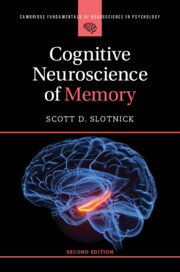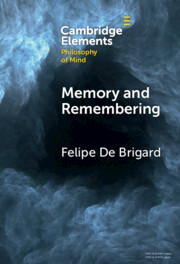Refine search
Actions for selected content:
140 results
Chapter 2.10 - Memories
- from Part II - Near-Death Experiences
-
- Book:
- Near-Death Experiences
- Published online:
- 30 August 2025
- Print publication:
- 04 September 2025, pp 139-147
-
- Chapter
- Export citation
Assessing everyday action in young adult athletes using the Virtual Kitchen Challenge: Relations with conventional cognitive tests
-
- Journal:
- Journal of the International Neuropsychological Society , First View
- Published online by Cambridge University Press:
- 01 September 2025, pp. 1-7
-
- Article
- Export citation

Cognitive Neuroscience of Memory
-
- Published online:
- 12 June 2025
- Print publication:
- 30 January 2025
-
- Textbook
- Export citation
Chapter 7 - Belief, Judgment, and Knowledge
-
- Book:
- Explaining our Actions
- Published online:
- 17 April 2025
- Print publication:
- 08 May 2025, pp 135-157
-
- Chapter
- Export citation
Recall the Memory Argument for Inner Awareness
-
- Journal:
- Journal of the American Philosophical Association / Volume 11 / Issue 3 / September 2025
- Published online by Cambridge University Press:
- 23 April 2025, pp. 601-621
-
- Article
-
- You have access
- Open access
- HTML
- Export citation
Chapter Eleven - Long-Term Memory in Animals
-
- Book:
- Cognitive Neuroscience of Memory
- Published online:
- 12 June 2025
- Print publication:
- 30 January 2025, pp 261-283
-
- Chapter
- Export citation
Chapter Three - Brain Regions Associated with Long-Term Memory
-
- Book:
- Cognitive Neuroscience of Memory
- Published online:
- 12 June 2025
- Print publication:
- 30 January 2025, pp 51-78
-
- Chapter
- Export citation
5 - Advanced Quantum Probability Applications
-
- Book:
- Quantum Models of Cognition and Decision
- Published online:
- 14 November 2024
- Print publication:
- 21 November 2024, pp 129-177
-
- Chapter
- Export citation
Longitudinal association between depressive symptoms and cognitive function: the neurological mechanism of psychological and physical disturbances on memory
-
- Journal:
- Psychological Medicine / Volume 54 / Issue 13 / October 2024
- Published online by Cambridge University Press:
- 14 October 2024, pp. 3602-3611
-
- Article
-
- You have access
- Open access
- HTML
- Export citation
An EEG study to understand semantic and episodic memory retrieval in creative processes
-
- Journal:
- Proceedings of the Design Society / Volume 4 / May 2024
- Published online by Cambridge University Press:
- 16 May 2024, pp. 1147-1156
-
- Article
-
- You have access
- Open access
- Export citation
Bilingualism reduces associations between cognition and the brain at baseline, but does not show evidence of cognitive reserve over time
-
- Journal:
- Bilingualism: Language and Cognition / Volume 28 / Issue 1 / January 2025
- Published online by Cambridge University Press:
- 01 March 2024, pp. 66-74
-
- Article
-
- You have access
- Open access
- HTML
- Export citation
Visual associative learning to detect early episodic memory deficits and distinguish Alzheimer’s disease from other types of dementia
-
- Journal:
- Journal of the International Neuropsychological Society / Volume 30 / Issue 6 / July 2024
- Published online by Cambridge University Press:
- 23 February 2024, pp. 584-593
-
- Article
-
- You have access
- Open access
- HTML
- Export citation
9 - Memory Systems
-
- Book:
- Fundamentals of Developmental Cognitive Neuroscience
- Published online:
- 11 January 2024
- Print publication:
- 01 February 2024, pp 279-313
-
- Chapter
- Export citation

Memory and Remembering
-
- Published online:
- 13 November 2023
- Print publication:
- 21 December 2023
-
- Element
- Export citation
18 - Computational Models of Episodic Memory
- from Part III - Computational Modeling of Basic Cognitive Functionalities
-
-
- Book:
- The Cambridge Handbook of Computational Cognitive Sciences
- Published online:
- 21 April 2023
- Print publication:
- 11 May 2023, pp 567-610
-
- Chapter
- Export citation
5 - Formal Models of Memory Based on Temporally-Varying Representations
-
-
- Book:
- New Handbook of Mathematical Psychology
- Published online:
- 20 April 2023
- Print publication:
- 27 April 2023, pp 218-264
-
- Chapter
- Export citation
Cannabis use and episodic memory performance among adolescents: Moderating effects of depression symptoms and sex
-
- Journal:
- Journal of the International Neuropsychological Society / Volume 29 / Issue 8 / October 2023
- Published online by Cambridge University Press:
- 13 February 2023, pp. 715-723
-
- Article
-
- You have access
- Open access
- HTML
- Export citation
Chapter 5 - Episodic Memory
-
- Book:
- Cognitive Ontology
- Published online:
- 15 January 2023
- Print publication:
- 05 January 2023, pp 123-157
-
- Chapter
- Export citation
Positive schizotypy is associated with amplified mnemonic discrimination and attenuated generalization
-
- Journal:
- European Psychiatry / Volume 65 / Issue S1 / June 2022
- Published online by Cambridge University Press:
- 01 September 2022, p. S152
-
- Article
-
- You have access
- Open access
- Export citation
13 - Metacognition
-
-
- Book:
- Primate Cognitive Studies
- Published online:
- 28 July 2022
- Print publication:
- 11 August 2022, pp 314-340
-
- Chapter
- Export citation
